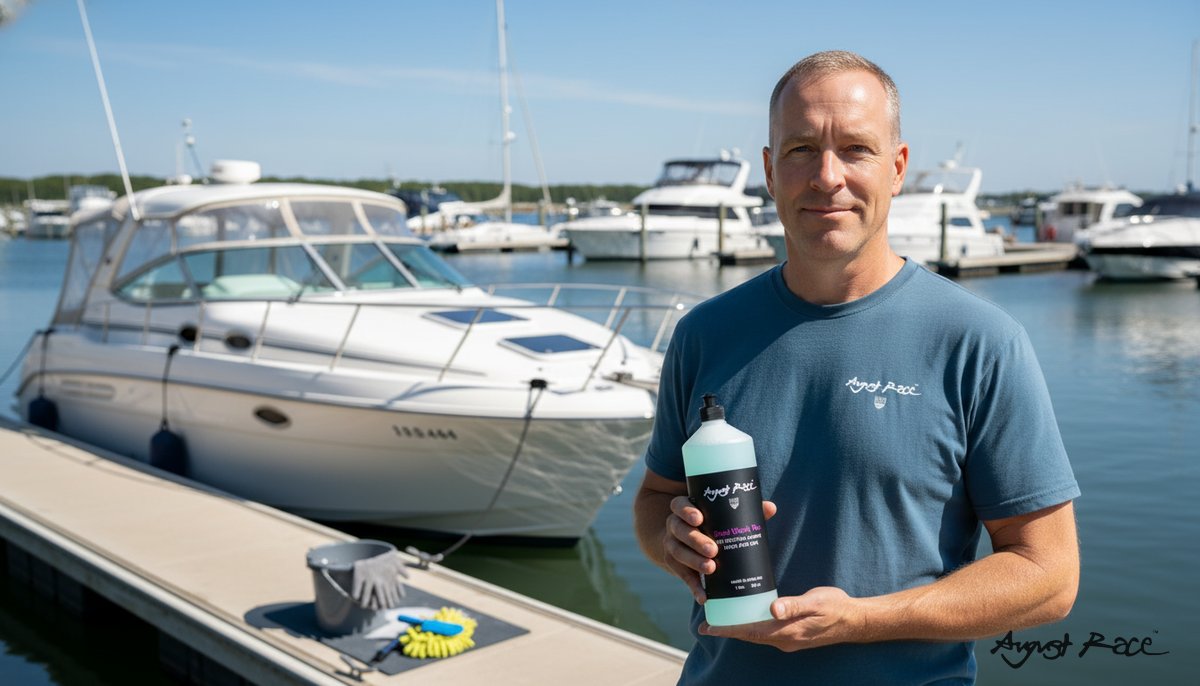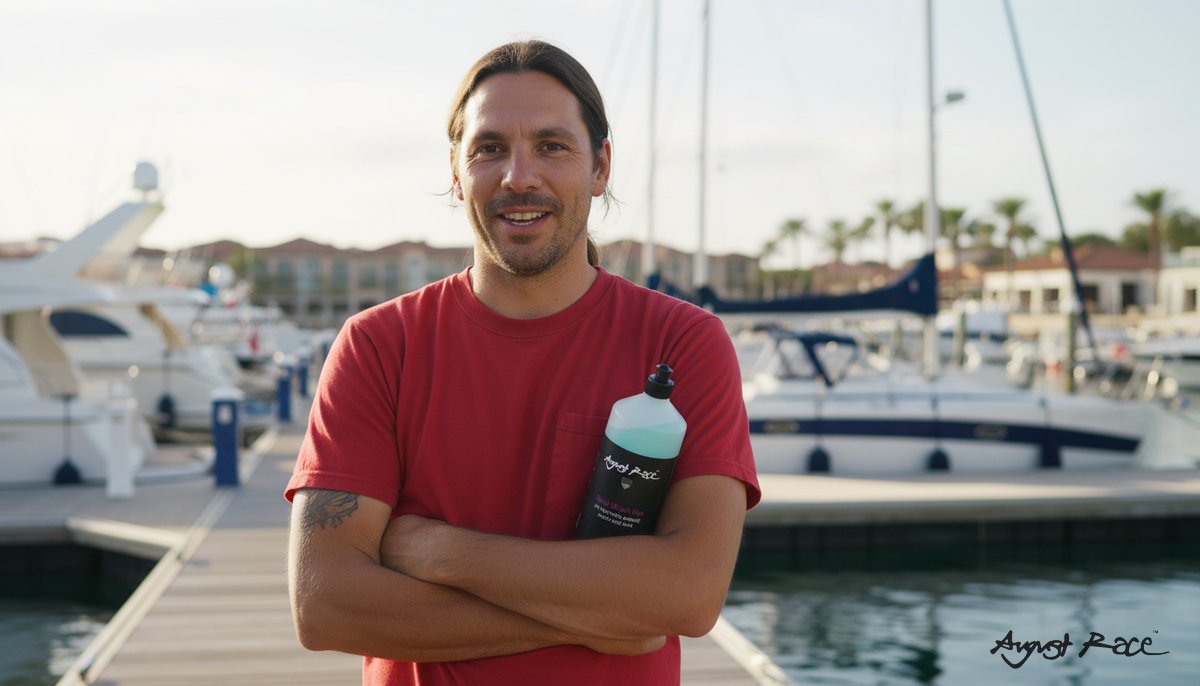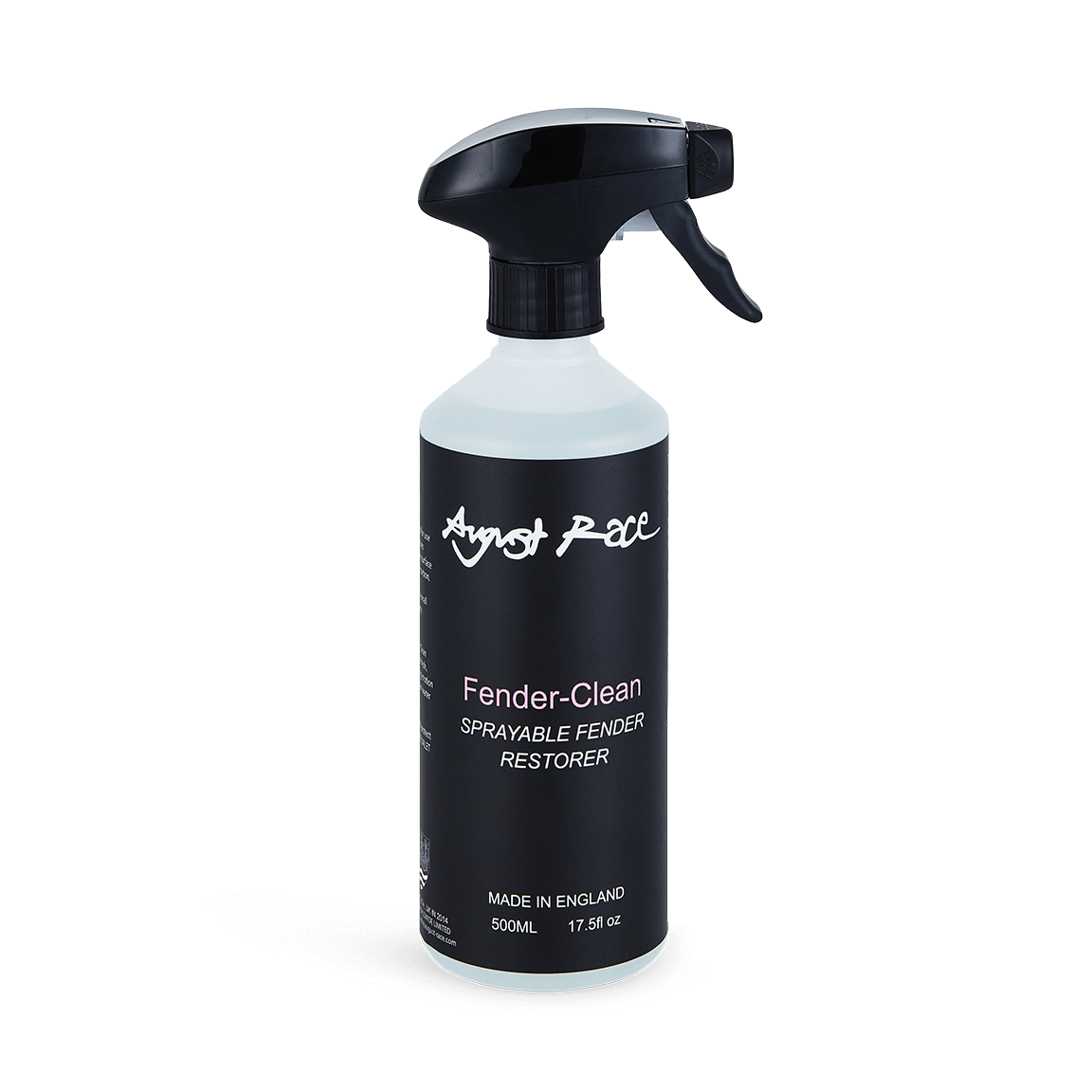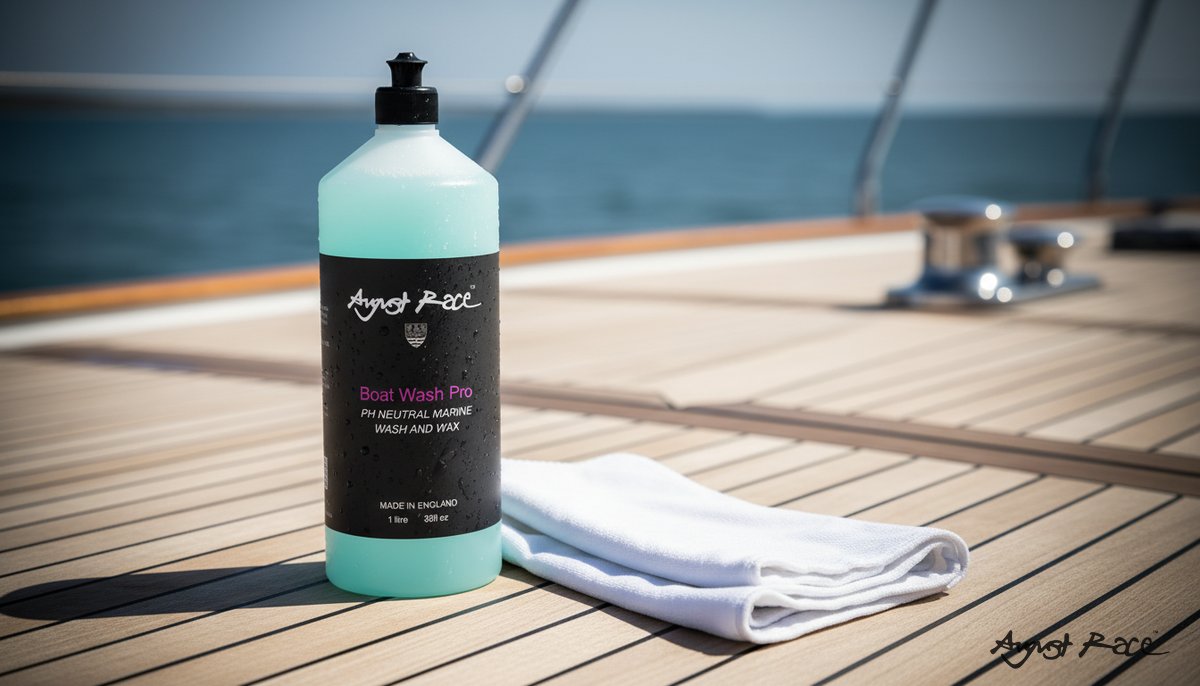How to Remove Salt from Painted Boats with a Streak-Free, Biodegradable Boat Wash
Salt deposits are abrasive, hygroscopic, and corrosive. On painted hulls and topsides, dried salt can etch clear coats, accelerate oxidation, and trap road film or dock grime. Consistent, paint-safe salt removal keeps surfaces smooth, reduces the need for aggressive polishing, and helps preserve color and gloss.
If your goal is reliable salt removal painted boat maintenance with minimal downtime, choosing the right process and product matters. This guide covers what to look for in a marine paint cleaner, a safe workflow for streak-free results, and how eco-friendly choices help meet marina expectations without sacrificing performance.
Consider using a dedicated, marine-grade wash such as August Race Boat Wash Pro. Review the manufacturer’s guidance to confirm paint compatibility, dilution, and any biodegradability claims before full use.
Why removing salt from painted boats matters for longevity
Salt crystals wick moisture and draw contaminants to the surface. On painted finishes and clear coats, this can lead to micro-abrasion and a dull, chalky appearance over time. Salt also holds onto grime; if not removed, it can grind into the finish during handling or docking, making it harder to remove grime from painted boat surfaces later.
Mechanically, repeated salt drying and re-wetting can etch, spot, and create “salt lines.” Chemically, salt exposure can accelerate oxidation of pigments and clear coats and promote corrosion on adjacent hardware. The result is more frequent compounding, shorter intervals between corrective polishing, and in severe cases, premature repainting.
Routine, gentle washing that dissolves and flushes salt helps preserve appearance and reduces long-term maintenance costs for owners and fleet managers. The key is a paint-safe process that removes salt thoroughly, avoids scratching, and leaves no film that could attract dirt or cause streaking.
Key features to look for in a marine paint cleaner
Selecting the right cleaner supports consistent results and fewer re-washes. When evaluating a marine paint cleaner, focus on these attributes:
- pH-balanced or mildly neutral formulation for modern marine paints and clear coats.
- Paint-safe surfactants that dissolve salt quickly and lift contaminants without harsh solvents.
- Good rinsability to minimize residue and help achieve a streak free cleaner outcome.
- Efficient performance with minimal dwell time to reduce water use and labor.
- Compatibility with gelcoat, two-part polyurethane, and acrylic marine paint systems (check manufacturer notes).
Environmental profile matters. A biodegradable boat wash with low toxicity supports compliance with marina rules and reduces impact on sensitive waters. “Biodegradable” refers to a product’s ability to break down into simpler substances through natural processes over time; it is distinct from “non-toxic,” which focuses on acute harm thresholds.
Performance indicators to check include user guidance for streak-free use, whether the product is safe for coated or waxed panels, and whether it leaves a protective film (some users prefer none before waxing). Always patch test on a small, inconspicuous painted panel. Apply per label, rinse, and inspect for gloss changes or residue before scaling up.
Step-by-step: How to clean salt off painted boats safely
The following workflow is designed to remove salt while protecting paint and reducing streaks.
-
Preparation
-
Work in cool, shaded conditions to slow drying.
-
Gather equipment: two buckets with grit guards, a low-pressure hose or sprayer, a soft wash mitt or sponge, and clean microfiber towels or a squeegee.
-
Inspect for peeling, oxidation, or damage. Mark sensitive areas to treat gently.
-
-
Dilution and application
-
Mix a concentrated, biodegradable boat wash per label. Start at the mild end of the dilution range; adjust only if needed.
-
Pre-rinse the surface with low pressure to dissolve and move loose salt.
-
Apply foam or suds from top to bottom in manageable sections to prevent drying.
-
If using a product like August Race Boat Wash Pro, follow the manufacturer’s dilution and application guidelines to support paint safety and rinsability.
-
-
Dwell and gentle agitation
-
Allow a short dwell time (typically a couple of minutes). Do not let the solution dry.
-
Using light pressure, wipe with a soft mitt in straight lines. Rinse the mitt frequently in a separate rinse bucket to avoid re-depositing salt crystals.
-
Avoid circular scrubbing that can instill fine swirls in paint.
-
-
Rinse technique for streak-free results
-
Rinse thoroughly with low pressure, again working top to bottom. Ensure runoff is clear and suds-free.
-
To reduce spotting and streaks, sheet water off the surface by holding the hose close without a nozzle.
-
Dry with clean microfiber towels, a chamois, or a silicone squeegee. Replace or rotate towels frequently to avoid streaking from damp or dirty cloths.
-
-
Post-clean checks
-
Inspect for salt shadows, water spots, or film. If residue remains, re-wash the affected section with fresh solution and a clean mitt.
-
If faint staining or oxidation persists after two gentle washes, consider a light, paint-safe polish on a test spot or consult a professional detailer.
-
This process aligns with best practices for how to clean salt off painted boats while aiming for a streak free cleaner finish. It also supports salt removal painted boat routines that reduce wear from unnecessary abrasion.
Why biodegradable boat wash formulas matter for marinas and sensitive waters
Biodegradability means a cleaner can break down through biological activity into simpler, less persistent substances over time. This differs from “non-toxic,” which typically refers to acute toxicity thresholds and does not guarantee environmental breakdown.
Many marinas and local authorities encourage or require the use of eco-preferable cleaners to minimize runoff impacts. Using an eco-friendly paint safe boat wash can help meet these expectations while still providing effective cleaning when used as directed.
A well-formulated biodegradable boat wash balances surfactant strength with rinsability, allowing quick salt release and low residue. Common concerns about effectiveness compared to conventional detergents often come down to technique and dilution; correct mixing, short dwell, and thorough rinsing can close most performance gaps while supporting lower environmental impact.
Troubleshooting: Achieving streak-free results on painted surfaces
Streaks typically come from a few controllable factors:
- Insufficient rinsing leaves surfactant film.
- Dirty or saturated towels spread residue.
- Working in direct sun dries solution prematurely.
- Over-concentrated soap increases film and water spotting.
Corrective actions for streak free marine cleaning:
- Re-rinse with low pressure, then dry with fresh microfiber.
- Work in shade and smaller sections; keep panels wet until final rinse.
- Adjust dilution toward the milder end and mix fresh solution.
- Avoid buffing until panels are fully dry; buffing damp film can create streaks.
If mineral etching or oxidation remains, washing alone may not resolve it. Move to a light, paint-safe polish on a test area or consult a professional. Most streak issues respond to dilution, shade, clean towels, and thorough rinsing rather than stronger chemicals.
Routine maintenance plan: keeping painted finishes salt-free between washes
- After each saltwater outing: Freshwater rinse from top to bottom. This quick step removes most salt before it hardens.
- Weekly for frequent use: Light wash with a biodegradable boat wash at mild dilution. Focus on areas that collect spray and hardware seams where salt accumulates.
- Monthly or as needed: Deeper clean and inspection. Address stubborn deposits early to remove grime from painted boat surfaces without harsh methods.
- Storage and drying: Promote airflow; avoid trapping moisture under covers. Where possible, position the boat to minimize salt spray exposure while moored.
Choose a cadence that fits your use pattern and time. Regular, brief rinses often reduce total labor compared to infrequent heavy cleanups and help with ongoing salt removal painted boat care.
Choosing the right cleaner: quick checklist for paint-safe, eco-friendly performance
Use this checklist to evaluate a marine paint cleaner for your boat and marina:
- pH-balanced or mildly neutral; paint-safe surfactants.
- Biodegradability claim from the manufacturer; review safety or technical data sheets if available.
- Notes on compatibility with gelcoat and two-part paints.
- User guidance for streak-free use and rinsability.
- Avoid strong solvents, petroleum distillates, or high-alkali content on painted finishes.
- Consider concentrated formulas for cost-effectiveness; buy sample sizes first when possible.
- Always patch test and follow dilution/application instructions exactly.
When you’ve identified an eco-friendly paint safe boat wash that meets these criteria, integrate it into your routine and monitor results over two to three washes.
Next step: protect your paint with a tested, streak-free routine
Put a simple 30-day salt-control plan in place:
- Immediately rinse after each saltwater trip.
- Perform biweekly washes with a biodegradable boat wash at the mildest effective dilution.
- Inspect monthly for early signs of oxidation or etching and address them promptly.
If you’re selecting a product, consider trying a concentrated, marine-grade wash such as August Race Boat Wash Pro on a small test area first. Track results over two uses to confirm ease of rinsing and streak control. Review manufacturer data sheets and marina guidelines before bulk purchasing or scheduling team-wide use.
For added water beading and UV support after washing and drying, a periodic protective coat can help. See Smooth Opacity UV wax for a high-gloss sealant option.
With a repeatable process and the right cleaner, salt removal painted boat maintenance becomes straightforward, helping protect finish quality and reduce long-term corrective work.
FAQs: common questions about cleaning painted boats and eco-friendly products
How to clean salt off painted boats without damaging the paint?
Rinse thoroughly with low pressure to dissolve loose salt, then wash in the shade using a pH-balanced, paint-safe cleaner at mild dilution. Work top to bottom, keep panels wet, and dry with clean microfiber to reduce streaks and spotting.
What is an eco-friendly paint safe boat wash and does it work as well as conventional cleaners?
An eco-friendly paint safe boat wash uses biodegradable surfactants and avoids harsh solvents while remaining compatible with modern marine paints. When mixed and rinsed correctly, performance is comparable for routine salt and grime, with the added benefit of supporting marina and local environmental expectations.
How do I get streak free marine cleaning results on painted surfaces?
Avoid direct sun, use fresh solution at the mildest effective dilution, and rinse thoroughly. Dry with clean microfiber or a squeegee, swapping towels as they become damp, and re-rinse any areas that show film before final drying.
How can I remove grime from painted boat surfaces without sanding or polishing?
Start with a thorough wash using a biodegradable, pH-balanced cleaner and gentle agitation with a soft mitt. If residue persists after two washes, spot-treat with a slightly richer dilution or use a light, paint-safe cleaner wax on a small test area before considering polishing.
About the Author
August Race Team
The August Race professional team brings decades of marine industry expertise and product development knowledge.
Get Expert Tips
Subscribe for marine care insights and product updates from industry professionals.
No spam. Unsubscribe anytime.
You May Also Like

Best Boat Wash for Marinas: August Race Boat Wash Pro
Scale a fast, compliant boat wash across busy slips. See how August Race Boat Wash Pro handles salt, stains, and algae removal with marina-ready efficiency.

Gelcoat Cleaning: Remove Salt Buildup | Boat Wash Pro
Stop salt haze fast. A yacht owner’s gelcoat cleaning routine using biodegradable Boat Wash Pro -- marine grime removal and streak-free results, marina-safe.

Boat Fender Cleaner: Pro Guide to August Race Fender Clean
Remove salt, oil, and biofilm from PVC and rubber fenders with a marine grime remover. Technician steps, safety, and FAQs on eco-friendly fender cleaner.
